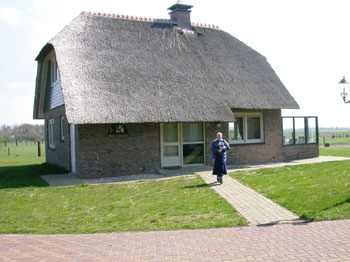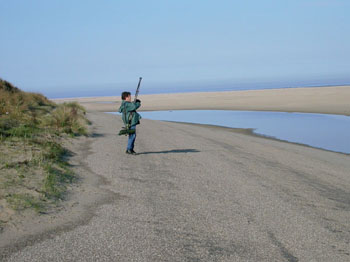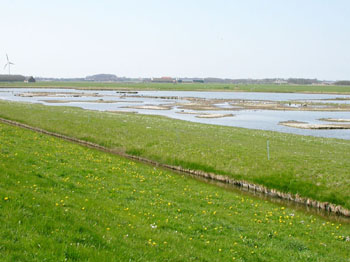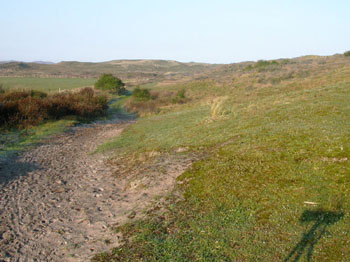The island of Texel forms part of the Dutch Wadden Islands, which are situated in the Wadden Sea a 20 minute ferry ride from the Dutch mainland, which is accessed from the port of Den Helder a 1 hour drive from Schipol airport.
 Although Texel is ideally suited to a fly drive holiday with all the main car hire company’s situated at Schipol, none driving birders are also catered for with a train service from Schipol to the ferry at Den Helder. Once on the Island all the birding spots are easily accessible by bike, which can be hired all over the island.
Although Texel is ideally suited to a fly drive holiday with all the main car hire company’s situated at Schipol, none driving birders are also catered for with a train service from Schipol to the ferry at Den Helder. Once on the Island all the birding spots are easily accessible by bike, which can be hired all over the island.
Texel is the largest of the islands with an amazing diversity of habitats for such a small island; it is a popular holiday destination for both the Dutch & the Germans.
Accommodation on the island caters for all tastes from 5 star hotels to small family run guesthouses, camping sites and self-catering facilities.
 Vast dune systems run the total length of the west coast and are edged with large tracts of pine forest. The East coast has extensive man made sea defences and being the more sheltered of the coasts, holds large numbers of ducks and grebes especially in the winter.
Vast dune systems run the total length of the west coast and are edged with large tracts of pine forest. The East coast has extensive man made sea defences and being the more sheltered of the coasts, holds large numbers of ducks and grebes especially in the winter.
The island is dissected by various sized drainage canals and ditches, with many freshwater pools dotted about providing excellent feeding and bathing areas as well as high tide roosts for thousands of ducks and waders. The Wadden Sea around Texel is rarely deeper than 5 meters and consists in the main of fluvial sediments, ideal habitat to provide year round food for hungry waders.
Because of its location Texel is an all the year round birding destination. Spring can provide many migrants through the island and because of its size many of these birds are concentrated into confined habitats. Summer brings many breeding birds with large colonies of terns, gulls & Spoonbills as well as many waders. Bittern also breed and we have yet to visit the island when one or more of us have not seen at least one. Winter sees the island full of over wintering waders, ducks, geese and thrushes.
 The trip report below covers our latest trip to the island, which took place in April 2004. The bird list consists only of birds seen during the trip. The predominant weather was dry & sunny, with a strong west, to south-westerly breeze. Tuesday 20th was heralded by a sharp ground frost, the only one of the trip.
The trip report below covers our latest trip to the island, which took place in April 2004. The bird list consists only of birds seen during the trip. The predominant weather was dry & sunny, with a strong west, to south-westerly breeze. Tuesday 20th was heralded by a sharp ground frost, the only one of the trip.
As stated above we have now visited the island in all 4 seasons and it’s obvious that the island is an all round birding destination, each season having something different to offer. The lasting memory of this trip will be the cacophony of sound made by the many displaying waders and terns that breed on the island.
 Bar & Black-tailed Godwits, Lapwing, Redshank & Curlew all compete to outdo each other with the backdrop of booming Bitterns. The trip provided 84 species, which is a fair return as only 3 days were devoted to serious birding, the other 2 days, were taken up with travelling.
Bar & Black-tailed Godwits, Lapwing, Redshank & Curlew all compete to outdo each other with the backdrop of booming Bitterns. The trip provided 84 species, which is a fair return as only 3 days were devoted to serious birding, the other 2 days, were taken up with travelling.
Although passerines are on the island at this time of year, they appear to be few and far between, and require a good deal of searching out. Several falls however were noted with these occurring towards the end of the week. These included; Blackbirds, thrushes, Ring Ouzels, Wheatears, Pipits & various Hirundines.
Schipol is only 1 hours flying time from most British Airports and Texel can be reached within a couple of hours of landing. The island is a very popular birding spot for the Dutch but seems to be almost totally ignored by the British.
Bird List
- Great Crested Grebe Podiceps cristatus Good numbers of birds seen in all suitable habitats.
- Little Grebe Tachybaptus ruficollis Several birds at Hors Polders.
- Cormorant Phalacrocorax carbo Birds seen on all coasts in small numbers.
- Bittern Botaurus stellaris Brief view of 1 bird. Up to 3 males heard booming at Hors Polders.
- Little Egret Egreta garzetta 1 bird seen en route.
- Grey Heron Ardea cinerea Birds common at all suitable habitats.
- Spoonbill Platalea leucorodia 100> birds at nesting colony & odd birds seen throughout the island.
- Mute Swan Cygnus olar Small numbers at suitable locations.
- Greylag Goose Anser anser Probably the most common goose on the island, many with goslings in tow.
- Barnacle Goose Branta leucopis 3 birds seen from hide at Waagelot.
- Brent Goose Branta bernicla The second most common goose with possibly 100-150 birds still on the island.
- Egyptian Goose Alopochen aegyptiacus Up to 12 pairs of birds on the island.
- Shelduck Tadorna tadorna Common at all suitable sites.
- Wigeon Anas penelope Small numbers encountered.
- Gadwall Anas strepera 4 pairs present at Hors Polders.
- Teal Anas crecca Very few birds left on the island.
- Mallard Anas platyrhynchos The most common duck with birds at all suitable locations.
- Shoveler Anas clypeata Flocks of 10 not uncommon.
- Pochard Aythya farina Small numbers seen on the Hors Polders.
- Tufted Duck Aythya fuligula The second most common duck with pairs on most suitable bodies of water.
- Common Eider Somateria mollissima Few birds on the coast. 50> were encountered on De Slufter.
- Ruddy Duck Oxyura jamaicensis A pair on the Hors Polders with male bubbling.
- Red Kite Milvus milvus 1 male seen flying over De Moy.
- Marsh Harrier Circus aeruginosus Several birds encountered mainly males which we assumed had arrived before the females to stake claim to a territory.
- Hen Harrier Circus cyaneus The most common raptor on the island with birds present at all suitable locations.
- Sparrowhawk Accipiter nisus Just 1 record for the trip.
- Common Kestrel Falco tinnunculus Although not common, birds were encountered most days.
- Pheasant Phasianus colchicus Almost at plague proportions.
- Moorhen Gallinula chloropus Surprisingly small numbers of birds, for such a lot of suitable habitat.
- Coot Fulica atra Birds common at all suitable sites.
- Avocet Recurvirostra avosetta Many birds at all suitable locations. Island population probably in excess of 150 breeding pairs.
- Ringed Plover Charadirus hiaticula Many birds on territory.
- Lapwing Vanellus vanellus Extremely common all over the island.
- Dunlin Calidris alpina Surprisingly few birds on the island with a handful at Waagelot on 20th, with 20> birds at De Moy on 22nd.
- Common Snipe Galinago galinago 1 singleton flushed at the Little Gardens, 1 heard drumming at the Hors Polders.
- Black-tailed Godwit Limosa limosa The most common of the Godwits, with an estimated population of several hundred.
- Bar-tailed Godwit Limosa lapponica Fair numbers of birds encountered.
- Oystercatcher Haematopus ostralegus Island population in excess of 10,000.
- Curlew Numenius arquata A very common wader on the island.
- Spotted Redshank Tringa erythropus 2 birds at De Slufter 23rd.
- Common Redshank Tringa totanus Very common both inland and on the coast.
- Greenshank Tringa nebularia Odd birds only.
- Red-necked Phalarope Phalaropus lobatus Just 1 bird at De Moy.
- Turnstone Arenaria interpres Small flocks encountered most days.
- Black-headed Gull Larus ridibundus Common at most suitable sites.
- Common Gull Larus canus Common at most suitable sites.
- Herring Gull Larus argentatus The most common gull of the region.
- Lesser Black-backed Gull Larus fuscus Good numbers.
- Great Black-backed Gull Larus marinus 1 juvenile at Waagelot.
- Sandwich Tern Sterna sandvicensis 100> pairs in the colony at Waagelot.
- Common Tern Sterna hirundo The commonest tern of the region with several hundred pairs at the traditional breeding sites.
- Little Tern Sterna albifrons The least common of the terns with approximately 30-50 pairs on the island.
- Woodpigeon Columba palumbus Common all over the island.
- Collared Dove Streptopelia decaocto Small numbers of birds usually around the farms.
- Short-eared Owl Asio flammeus Bird seen at day time roost at the Little Gardens.
- Skylark Alauda arvensis Small numbers of birds seen throughout the island.
- Sand Martin Riparia riparia Obvious migration during second half of the week.
- Swallow Hirundo rustica Large influx into the island in 2nd half of the week.
- House Martin Delichon urbica Same status as Swallow.
- Tree Pipit Anthus trivialis 2 birds on territory at the Hors Polders.
- Meadow Pipit Anthus pratensis Odd birds seen usually on the grass dykes on the east of the island.
- Yellow Wagtail Moticilla flavissima 1 bird seen from hide at Waagelot.
- White Wagtail Moticilla alba Several birds encountered.
- Wren Troglodytes troglodytes Birds encountered in the Little Gardens & pine woods.
- Dunnock Prunella modularis Birds confined to west coast woods.
- Robin Erithacus rubecula A common bird at all suitable locations.
- Bluethroat Luscinia svecica 4 white-spotted males on territory at the Hors Polders.
- Stonechat Saxicola torquata Surprisingly few birds although habitat looks ideal, a pair of birds at the Little Gardens the only record.
- Northern Wheatear Oenanthe oenanthe Obvious migration with several males disputing territories around the lighthouse.
- Ring Ouzel Turdus torquatus Several males seen at the Little Gardens.
- Blackbird Turdus merula One of the most common passerines on the island.
- Fieldfare Turdus pilaris 1 bird at the Little Gardens only sighting of the trip.
- Song Thrush Turdus philomelos Several birds seen.
- Blue Tit Parus caeruleus Although not common, they could usually be found in the woods to the west.
- Great Tit Parus major Status similar to Blue Tit.
- Jay Garrulus glandarius Common in suitable habitats, birds seen most days around hotel at De Koog .
- Magpie Pica pica A very common bird over most of the island.
- Jackdaw Corvus monedula The most common corvid on the island with flocks of 50+ not uncommon.
- Carrion Crow Corvus corone Birds common at suitable habitats.
- Starling Sturnus vulgaris Common bird throughout the island with birds seen at most habitats.
- House Sparrow Passer domesticus Most farms on the island have shelter belts and wind-breaks which hold mixed flocks of both House & Tree Sparrows.
- Chaffinch Fringilla coelebs Appear to be commoner on the East coast, a flock of 30+ birds at De Slufter 18th.
- Greenfinch Carduelis chloris Small numbers at suitable sites.
- Goldfinch Carduelis carduelis Only 1 record of a single bird 14th.
- Reed Bunting Emberiza schoeniclus Birds locally common at Hors Polders.
